Strengthening Exercises
Strengthening exercises are activities that are developed to improve the strength of precise groups of muscles. Strengthening workouts overload the muscles until the point of muscle exhaustion. This pressure and overload of a muscle stimulates growth, improving strength. Weak muscles can raise the risk of injury to the surrounding joints and soft tissues.
Muscular power is an essential part of overall wellness and can enhance your health, in addition to increasing your confidence. You also build endurance so your muscles can function hard without making you exhausted afterward.
Strength training usually needs some form of resistance for your muscles to work against, from free weights, resistance machines, or resistance bands. If you are just beginning and do not have access to gym equipment, your body can show sufficient resistance to get you going with the simple exercises detailed here.
What are strengthening exercises?
Strengthening exercises are specific training movements that aim to enhance the strength of specific muscles by working them against resistance. They are usually used in the rehabilitation stage, especially when you are experiencing muscle dysfunction that is causing pain. Muscular strength is vital for joint function and stability.
For the tasks that you need strengthening for select the specific strengthening activities that will assist you in reaching your goals e.g. an athlete who plays tennis will perform actions that will especially help improve their sports performance. Strengthening exercises can be specified for any muscle(s) in the body. Your therapist may use resistance in the form of your body weight, workout machines, free weights or barbells, water (e.g. pool), stairs, or elastic bands.
Strength exercise is any workout that makes your muscles function properly rather than regularly. Your muscles get bigger, stronger, more powerful, and more resilient as a result. You should try to do two sessions or more of muscle-strengthening workouts a week.
Let’s begin with the basics: Your workout routine should contain a mix of cardio and strength training. Strengthening exercises can involve some hand weights or just your body weight. As you get stronger and require more of a challenge, weights will be your new best friend. But don’t sleep on cardio. It is still a required(and sometimes evil) part of any exercise plan. Your main concentration is on cardio workouts to get good muscle growth.
From the research review of the 2016 study, strengthening exercises done at least 2 days a week is perfect for growing your muscles. So initiate with two or three days of whole-body weight workout, two days of rest, and two days of cardio. When you achieve strength, you can attempt rotating between upper- and lower-body exercises on a fourth-weight daytime. Additionally, make sure to set aside at least two days a week for your body to rest and recuperate.
Advantages of Strengthening Exercises:
There are many advantages of strengthening workouts. Some of the benefits of receiving a strengthening training program are:
- Muscle strength is enhanced
- Reduce energy expenditure as muscles are more efficient
- Decrease risk of injury
- Improve function
- Improve the quality of training
- Delay onset of arthritic conditions
- Workouts that build strength can help you in a lot of ways. Because you will be able to rely on the muscle, that will boost your confidence in it. Gaining muscle mass can help you maintain a healthy weight, increase your range of motion, and improve your balance. Strength training may help reduce mild depression and increase self-confidence. Additionally, it can support healthy cholesterol and blood sugar levels.
- Your daily activities may make you feel better. In addition to strengthening your muscles, strength training makes your bones stronger, which can help you prevent injuries. Moreover, your joints might hurt less.
- By building up your leg muscles instead of your back muscles, you can safely lift objects off the ground by strengthening your hip and leg muscles.
- Better posture, appropriate spinal movement, and spine stabilization are all made possible by stronger lower back and abdominal muscles.
Who would benefit from Strengthening Exercises?
Many people with different diseases and injuries could gain advantages from a program focused on strengthening exercises.
- Arthritic disorders
- Post-injury – strength is lost post-injury
- Pre-surgery – improving strength pre-surgery will improve the healing rate post-surgery
- Post-surgery – the surgery will result in reduced function which will reduce muscle strength
- After a period of immobility – muscles begin to atrophy if immobile.
- Movement dysfunction can be fixed by strengthening particular muscles.
- Individuals with poor posture – some muscles become weak and longer whereas others may be overexposed and become tight due to poor postures.
What do Strengthening Exercise Programmes Include?
Strengthening workout programs will contain a variety of activities designed to target typical groups or individual muscles. These activities will begin easier and progress as strength is developed.
- Movements against gravity
- The movement against the resistance of water
- The movement against a resistance band
- Workout with weight
- Workout
- Using your body weight as the load
Exercises intended to strengthen muscles can only be beneficial when the muscle is overworked. These workouts will be useful for reaching your desired outcome. For example, a squat would be a useful exercise if your objective is to be able to bend over and pick something up off the ground. This is because exercises that are not functional decrease compliance.
There are two types of strength-based exercises:
- Isometric: where during the exercise the muscle length and joint angle remain unaffected. Isometric exercises can be done in a motionless, stationary position.
- Isotonic: involves using muscles and joints to move in a controlled manner. When lifting a weight, for example, the muscle contracts and shortens in response to the load.
How does it help?
The muscles are strengthened by the resistance that the body has to work against during this kind of exercise. Tiny tears in the muscle tissue occur when you use resistance. After that, the muscle grows and becomes stronger as the body repairs and grows back. This prepares the muscles for a variety of activities you might encounter on any given day and enables the muscles to handle more difficult movements.
What do you mean by resistance?
You can use various tools to incorporate resistance training into your rehabilitation. As an illustration:
- Weight machines: Machines assist you act as a safe form as they have a fixed range of motion.
- Free weights: Contains dumbbells, kettlebells, and barbells. They allow you to perform many exercises that enable you to target specific muscles. They also supply a greater range of movement than set machines do.
How Do I Begin Strength Training?
Your physiotherapist will initially begin your strengthening program with low resistance. More weight or resistance will be added as your strength grows to make sure your muscles are still being challenged to produce the desired outcome.
Any activity that puts more strain on your muscles than usual is considered a strength exercise. Your muscles become bigger, stronger, more powerful, and more resilient as a result. These exercises require you to work against resistance or with your body weight. Try to complete two or more sessions of muscle-strengthening activities each week.
Illustrations of muscle-strengthening exercises include:
- Lifting weights
- Working with resistance bands
- Heavy gardening, such as digging and shoveling
- Climbing stairs
- Hillwalking
- Cycling
- Dance
- Push-ups, sit-ups, and squats
- Yoga
There are a lot of exercises included in strengthening exercises, here we explain some of them:
Do some warm-up exercises for 5 to 10 minutes. Warm-up Before the workout, you should do a warm-up exercise like walking, neck movement, and arm movements and add some light stretching. Hamstring and calf stretching you should be in your warm-up.
Lower body exercises
Walking squat
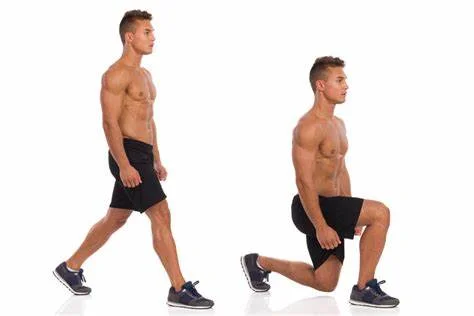
- With your feet hip-distance apart, begin in a squat posture. To sit back and simulate sitting in a chair, pull in your abs and bend your knees.
- Step your left foot to the right to return to the starting squat position after taking a step with your right foot to the right to enter a wide-leg squat.
- Repeat on the other side after ten more sideways steps. Then, stand back up and repeat.
Squat with a knee lift
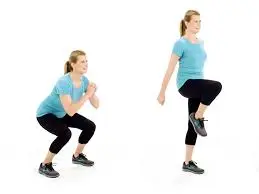
- To perform a side lunge, step with your left foot to the left, as though you’re attempting to get your left butt into a chair.
- Lift your left knee towards your chest and return to center by pressing off of your left foot.
- In addition to strengthening your right leg’s balance, turn your torso to the left to activate your core. Switch sides after ten repetitions of this.
Side lunge with a twist
- Step your left foot to the left into a side lunge as if you’re trying to sit your left butt down into a chair.
- Then press off of the left foot to come back to the center and raise the left knee toward your chest.
- To activate your core and improve your balance on your right leg, turn your torso to the left. After ten repetitions, switch sides.
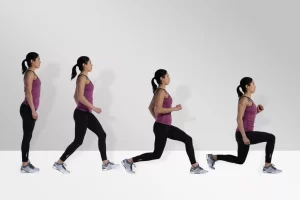
Half lunge with a walking
- Take a step with your feet hip-width apart. After that, advance your right foot and bend your right knee halfway to perform a half lunge.
- The left knee should be bent halfway down. This posture is called a half-lunge. Go ahead and perform 20 half-lunges while walking.
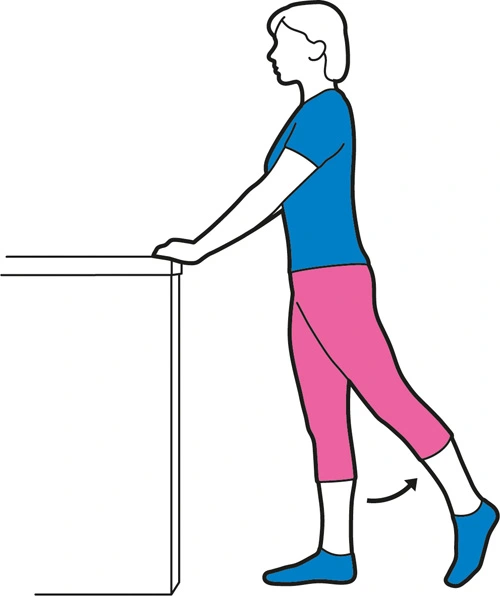
Standing leg lifts to the back
- Stand straight on your right leg with your left leg and move back.
- Pull your navel in toward your spine and raise your straight left leg behind you to work the buttocks muscles.
- Do this 10 times, then do it on opposite legs.
Pushups on the knees
Upper body exercises
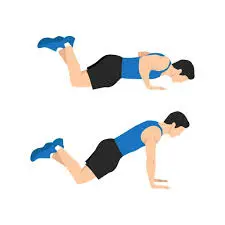
- Place your shoulders over your wrists and your knees under your hips as you take a quadruped position. Following that, extend the hands by approximately one foot while keeping the shoulders over the wrists. Lower into a pushup by pulling the navel in towards the spine and bending the elbows out to the sides. Reach back to the starting position by applying pressure with your palms. Do this ten times.
Tricep dips
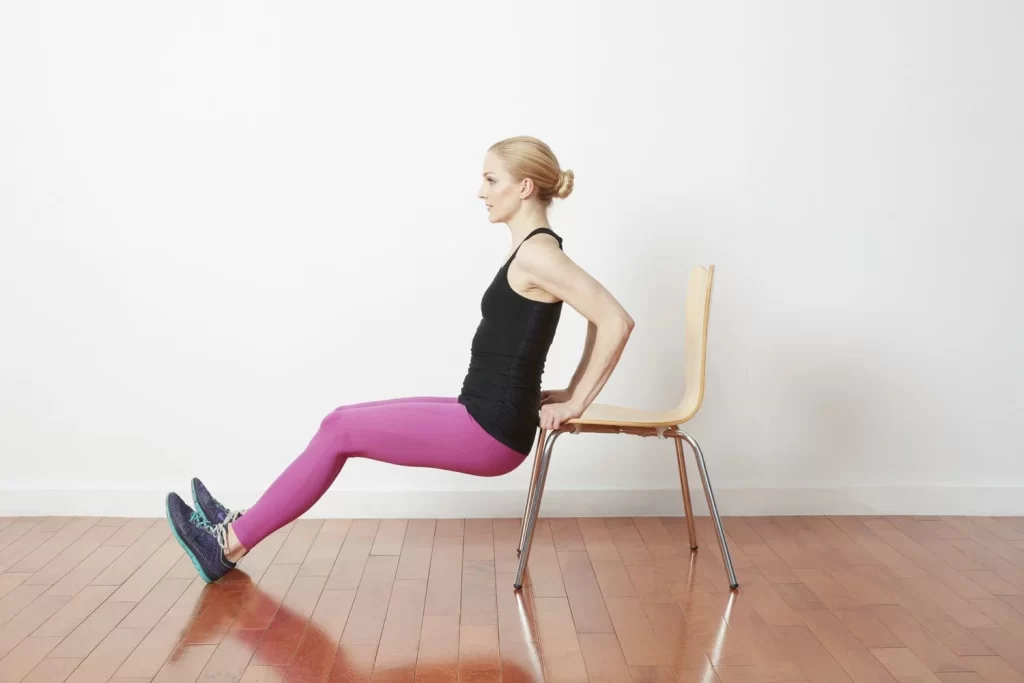
- Take a seat on your buttocks on the floor, and put your hands behind you. Turn the fingers to face your buttocks, and raise your buttocks off of the ground. Keep your knees over your ankles, and flex the elbows straight back lowering down into a tricep dip. Push down through the palms of the hands to extend the arms, while working the tricep muscle (the back of the arms). Do it ten times.
Plank to down dog
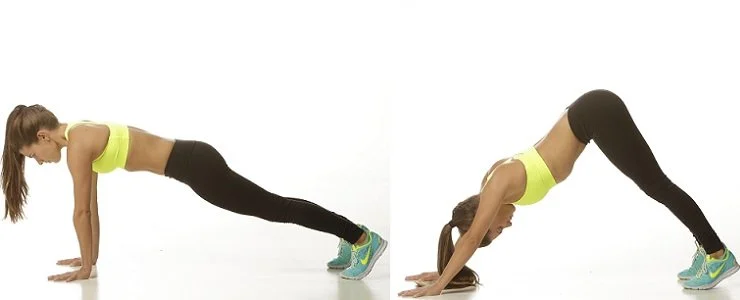
- Begin on your hands and knees, walk the knees back to tuck the toes under, and raise into a plank position. Hold a flat back as you keep the shoulders over the wrists and reach the heels toward the back of the room. Then, push the abs in and raise the buttocks toward the ceiling and back, coming into an upside-down “V” position. Take a breath in, and then breathe out as you shift forward into the plank. Do it ten times.
Lat pulldowns without machine
- Maintaining a straight posture, raise your arms shoulder-width apart and extend them upward towards the ceiling. After that, engage your upper back by pulling your arms and elbows down while imagining that you’re grasping a bar. Firmly compress the shoulder blades together. The arms should then be raised to their initial position. Do this ten times over.
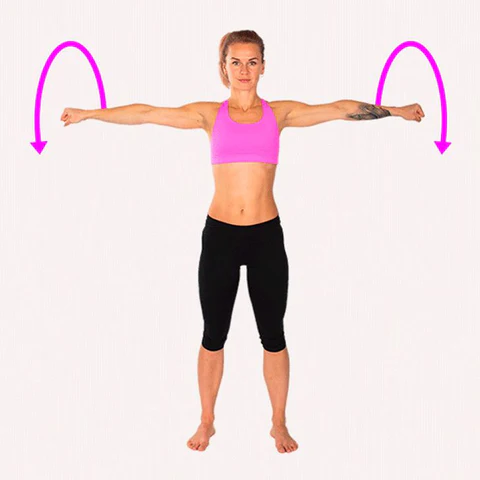
Arm circles
- Stretch your arms out to the sides to a height equal to your shoulders. Then, make ten circles, ten forward and ten backward. In total, repeat this ten times.
Core exercises
Crunch with knees up
- While lying on your back, flex your knees to a 90-degree position. With the elbows spread wide, place the hands behind the head. Raise the head and neck a little more than an inch off the ground. This is where things begin. As you curl up as high as you can and try to touch your knees with your elbows, contract your lower abs. Return to the starting position by lowering the head, neck, and elbows. Ten times over, repeat this.
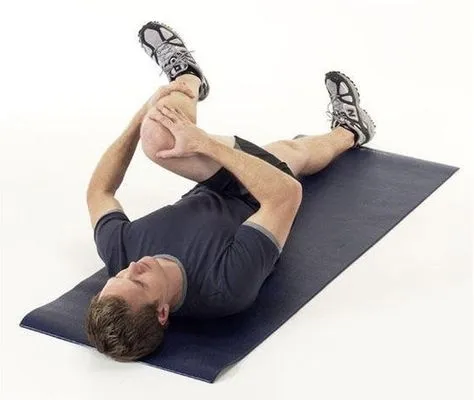
Criss-cross & reach with knees up
- Keep your knees raised at a ninety-degree angle while you are on your back. Close your hands in the center of your chest. Once you reach the arms across the right thigh, curl up and return to the center. Once you cross the left thigh with your arms, curl up and return to the center. Do this on both sides.
Straight-leg-raise
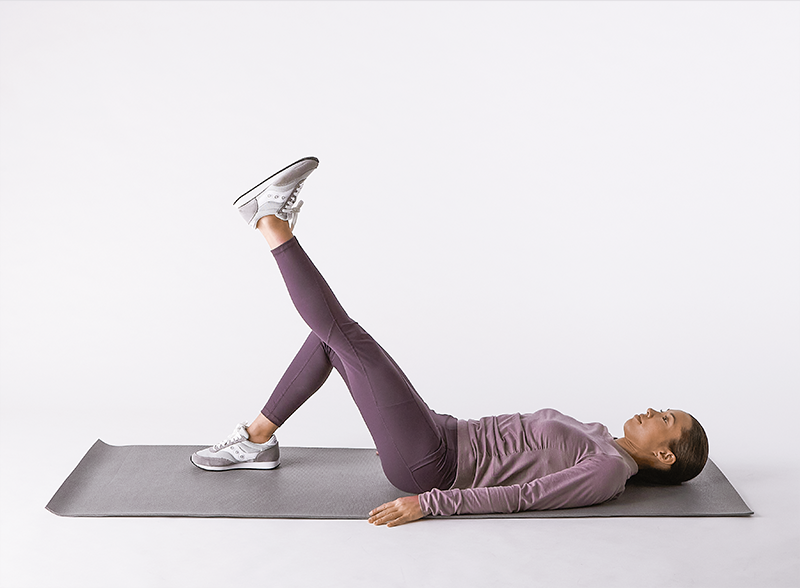
- While on your back, plant your left foot firmly on the floor and extend your right leg upward. Tilt your pelvis to press your lower back into the ground. Lower your right leg to about 45 degrees, then raise it to the center while maintaining your back pressed against the floor. After ten repetitions, switch legs.
Single leg straight toe touch
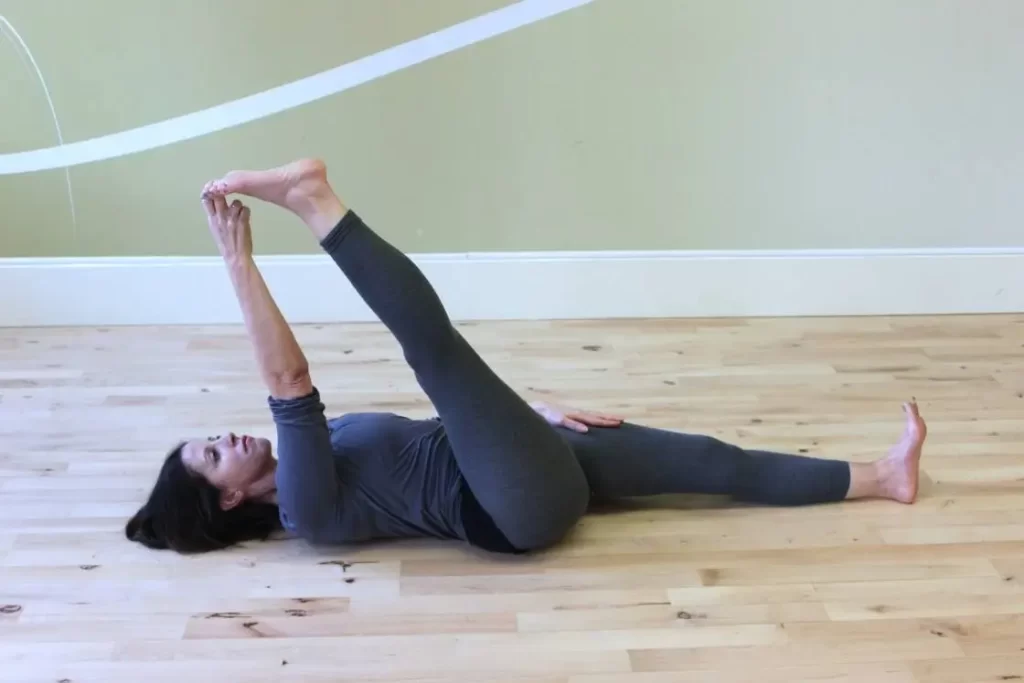
- Raise both arms and both legs towards the ceiling. As you bend your right leg and extend your fingertips to your left toes, raise your head and neck off the floor. Return to the center, bringing the right leg in, and lowering the left leg. Raise your arm to your right toe. On each side, repeat ten times.
Modified side plank elbow to knee
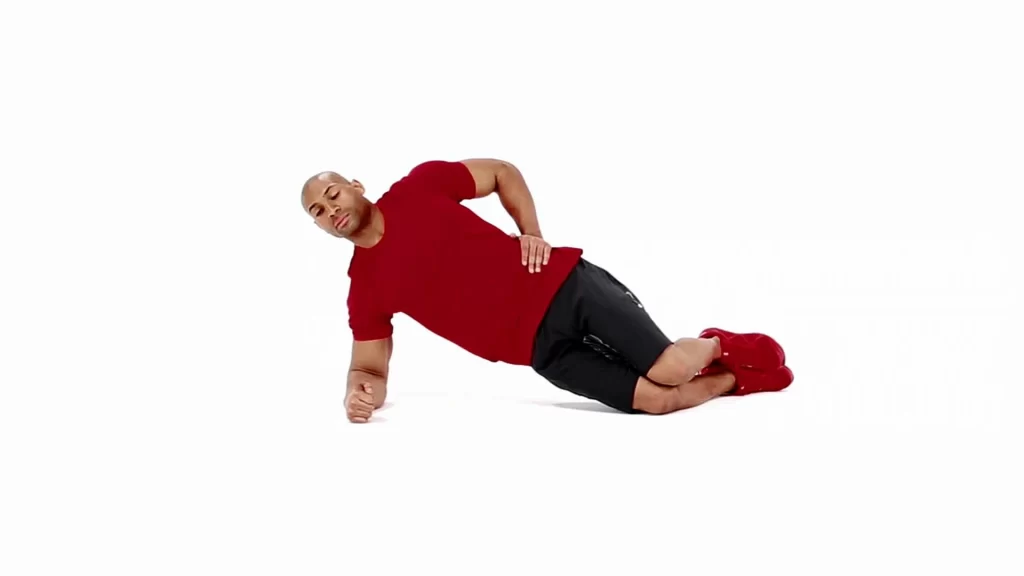
- Make sure your right shoulder stays over your right wrist as you lower your right hand to the ground to the right of your body while on your knees. Next, raise your left leg to your hip. Fold your left hand over your head and flex your left elbow to your left thigh. The left side waist will engage, even though your body won’t move all that much. Switch sides after ten repetitions of this.
Resistance band exercises
A resistance band is another great tool for your strength training routine. They are lightweight, portable, and effectively engage your muscles in the same way as free weights or weight machines, according to a 2010 study.
The resistance band pulls apart
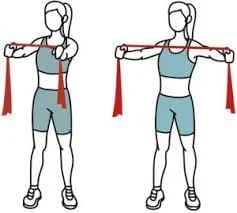
- The arms, shoulders, and back muscles are the primary focus of this exercise.
- To begin this exercise, Raise your arms to your chest and position them in front of you.
- Using both hands, firmly grasp a resistance band.
- Stretch your arms out to your sides and keep your arms straight to pull the band towards your chest. Perform this movement starting from your mid-back.
- Maintaining a straight spine, bring your shoulder blades together and return to the starting position slowly.
- Do one to three sets of fifteen to twenty reps.
Hip extension
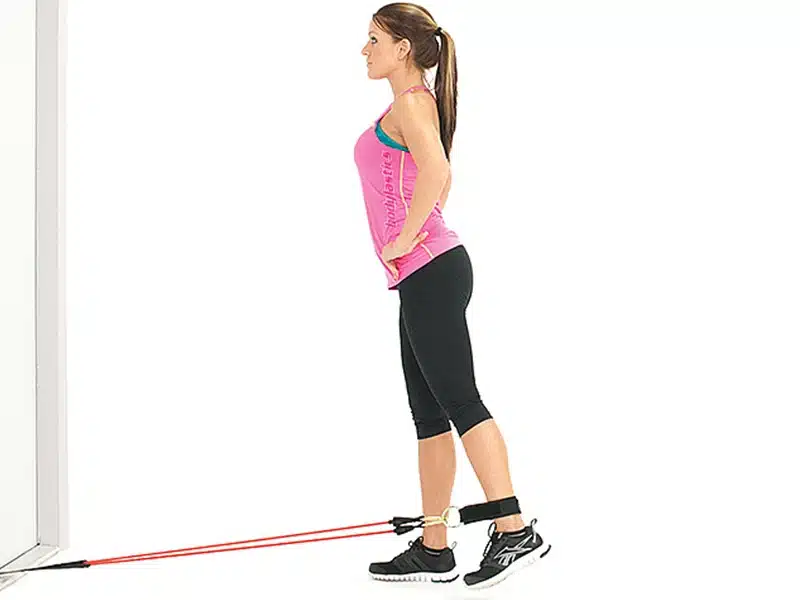
- This exercise works the muscles in your legs and hips. You will need a band with light to medium resistance to complete this exercise.
- Loop the resistance band around both of your two ankles.
- As you can, keep your left leg pulled back while keeping your body in a straight line.
- Gradually return to your initial position.
- Change to your right leg after 12 repetitions with your left leg.
- As your strength improves, work your way up to three sets per side, starting with two sets.
Resistance band leg press
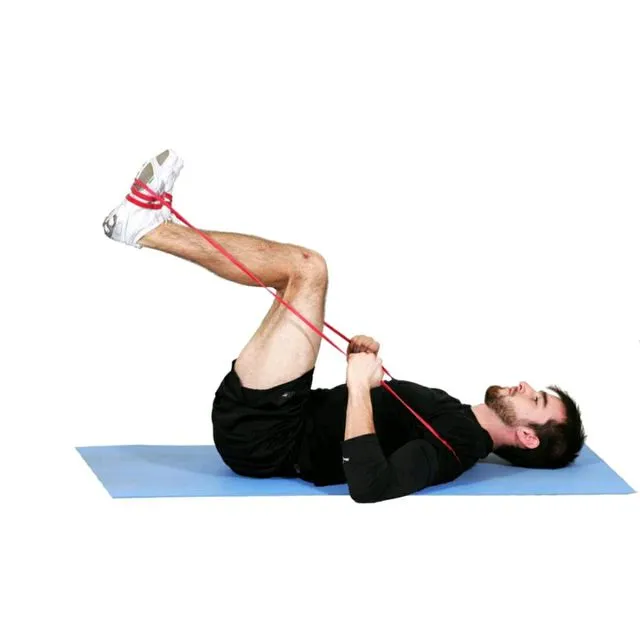
- These exercises focus on your quadriceps, hamstrings, calves, and glutes. This exercise is done against gravity.
- Lie on your back with your feet elevated off the ground.
- A 90-degree angle should be formed by the knees. When you flex your feet, point your toes upward.
- As you encircle your feet with the resistance band, hold onto its ends.
- Press your feet against the bands after extending your legs to their maximum length.
- Bend your knees to return to a 90-degree position.
- Perform 1-3 sets of 10–12 reps.
Free weight exercises
For the following exercises, we use dumbbells. Start light when using five-pound dumbbells. As you gain strength, you can move up to eight or ten-pound dumbbells. You can also use water bottles or cans in place of dumbbells. Just make sure you hold them tightly for their safety.
Dumbbell shoulder press
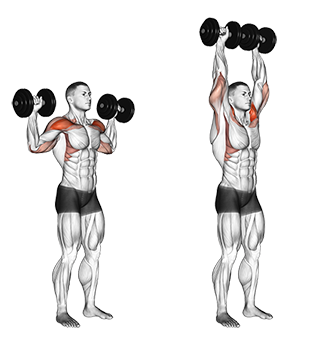
- This exercise targets the muscles in your arms and shoulders as well as your core and chest muscles.
- When you take a starting position, place your feet shoulder-width apart.
- Once you have the dumbbells picked up, raise them to shoulder height. Your palms can be positioned forward or facing your body.
- Raise the dumbbells above your head and reach out with both hands.
- Return the dumbbells to shoulder height after spending a brief period in this position.
- Perform 8–12 repetitions in 1-3 sets.
Dumbbell triceps kickback
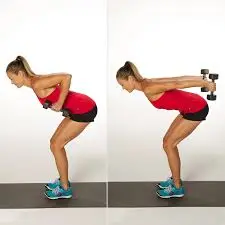
- This exercise works both the triceps and the muscles in your shoulders.
- Take two dumbbells and hold one in each hand.
- While bending your torso to a 45-degree angle, bend your elbows to a 90-degree angle.
- Next, while tensing your triceps, raise your arms straight back behind you.
- You can work one arm at a time or both at once.
- Work your way up to three sets of eight to twelve repetitions if you’re just getting started, as your strength increases.
Chest press
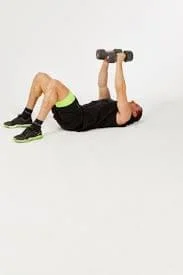
- The deltoids, pectorals, shoulders, and triceps are the main muscles that the chest press works.
- With your knees bent and your feet flat on the ground, lie face up on a bench or the ground.
- Press the dumbbells straight up while maintaining a brace on your core while holding them at the sides of your chest.
- After that, slowly lower the dumbbells before repeating. Do 3-6 sets of 4–8 repetitions.
Lying dumbbell fly
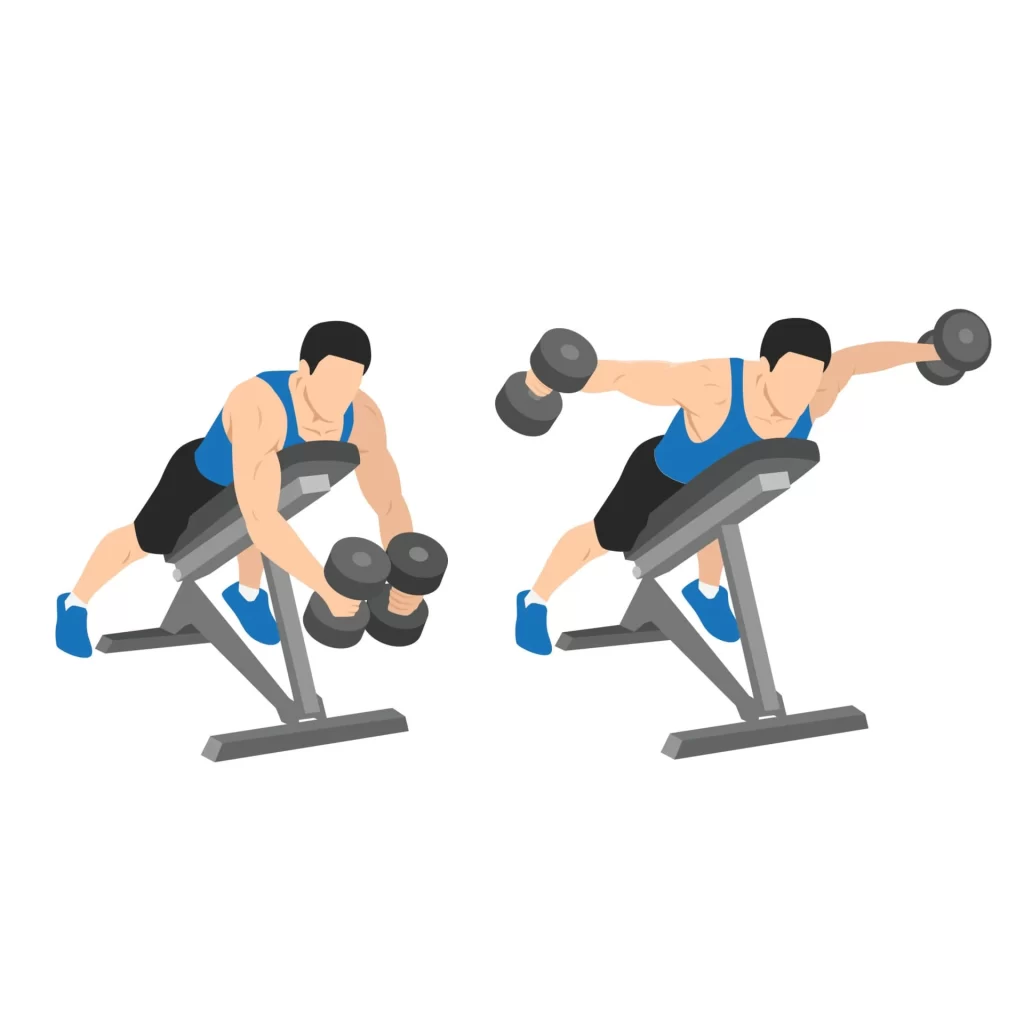
- If you want to strengthen your chest, dumbbell flies can help. These exercises can be done on the ground or on a bench. The deltoids, biceps, and pectorals will all be struck by this move. Bend your knees and lie down on a floor or bench. With your palms facing each other, hold the dumbbells straight above your chest. Bend your elbows to the point of comfort (or, if you’re not using a bench until they touch the floor) as you slowly lower the dumbbells to your sides. your elbows should be flexed slightly, raise the dumbbells posterior and above your chest level, and repeat. Do 3-6 sets of 4–8 repetitions.
Pullover
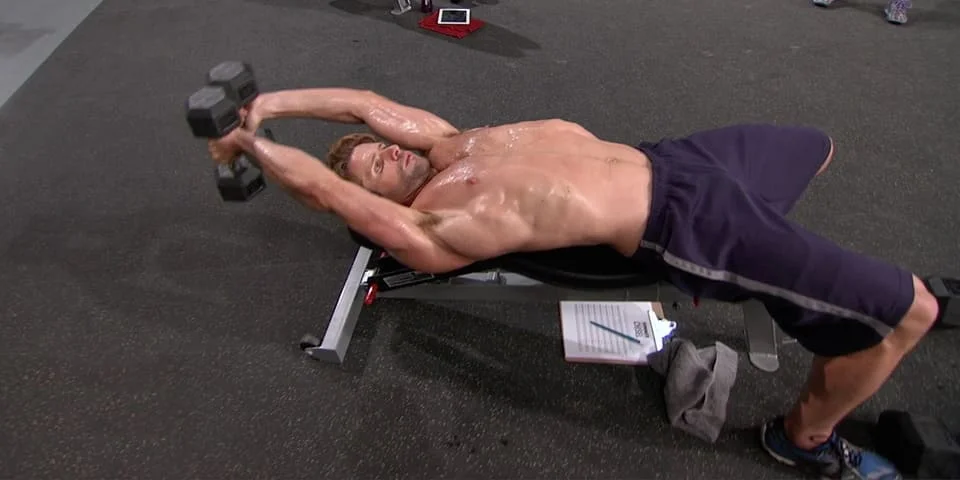
- Build your abs, pecs, and lats like a lumberjack cutting wood—without having to worry about your aim or an axe. You can perform this dumbbell exercise on a stability ball, a bench, or the floor. Just make sure you maintain a firm grip on the dumbbell!
- Position your feet on the base and lie face up. Dumbbells should be held single-handedly and raised above the chest. Bring the dumbbell back to its starting position after slowly extending it overhead while bending your elbows just a little. To ensure that you can handle this one comfortably, start with a low enough weight. Take no chances by letting the dumbbell fall on your head or chest. Do ten to twelve repetitions in three sets.
Biceps curl
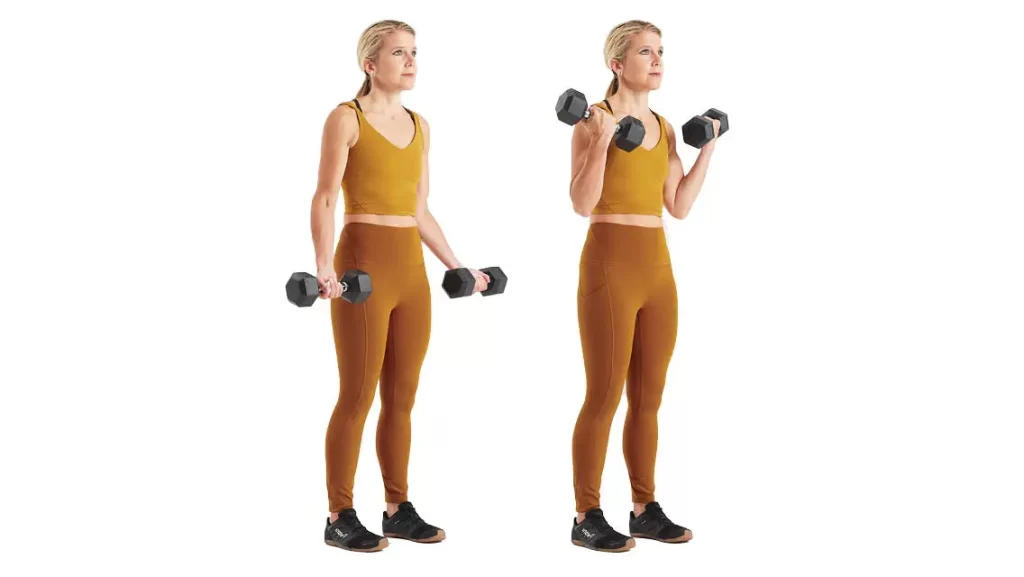
- This traditional biceps exercise strengthens your arms and develops the muscles you want to show off in the mirror. Dumbbells should be held straight down at your sides while you are sitting or standing. Rotate your arms so that the palms of your hands face your shoulders as you flex your elbows and raise the weights towards your shoulders. Retrace your steps slowly to the beginning and do it again. Do ten to twelve repetitions in three sets.
Wrist curl
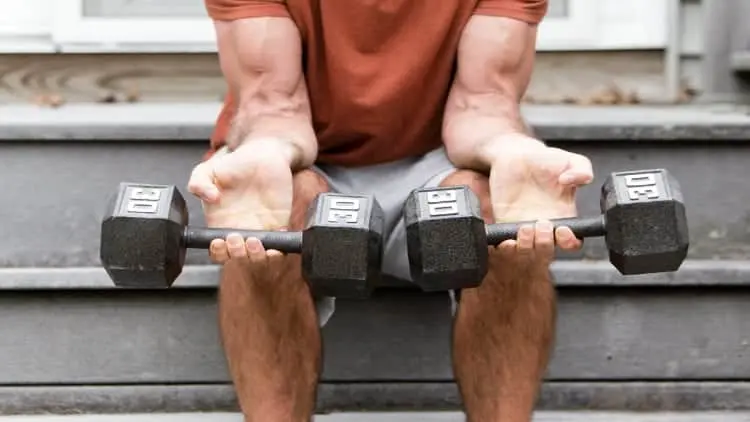
- This exercise strengthens the muscles in your forearms as well as your hands. From controlling a computer mouse to turning a doorknob, this frequently disregarded muscle group is employed for a variety of tasks.
- Taking a seat on a chair or bench, grasp a small dumbbell in each hand. Lay your forearms on your thighs, hands outstretched above your knees, and wrists resting atop them. Both up and down can be displayed on the palms. Lift the weights gradually and then release them. Move your hands only—don’t move your arms. Repeat. Perform three 12-rep sets.
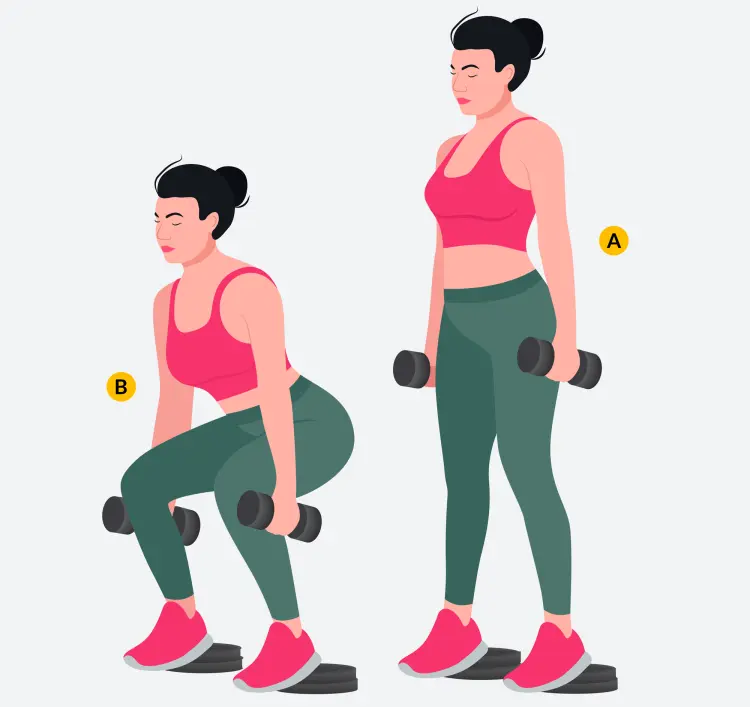
Dumbbell squat
- Squats alone work your main leg muscles, but you can activate those muscles even more by adding weight. You can add dumbbells to any squat variation to give yourself an extra challenge.
- Place the dumbbells at each shoulder and stand with your feet hip-width apart. Take a low seat while keeping your weight on your heels. Push your hips forward and upward and press through your heels to return to a standing position. Perform three 12-to 15-rep sets.
Dumbbell walking lunge
- Using dumbbells or altering your lunge form can make lunges more challenging. Walking lunges with dumbbells increase your grip strength and strengthen your quads and glutes, just like regular lunges do. Take a stand holding a dumbbell in each hand. Lunge forward with your right leg and descend so that your knee is 90 degrees from the floor. Push through your front foot to stand. Repeat by lunging with the other leg. For each side, complete three sets of ten repetitions.
Calf raises

- Keep dumbbells by your sides, exactly where your hips are as you stand. Keeping the weights by your sides and your toes on the floor, raise your heels. Drop your heels to the ground once more. One leg at a time or both at once, raise your heels while performing a seated calf raise by positioning the dumbbells over your knees. Perform three sets of fifteen to twenty repetitions.
How to cool down
After your workout, take a five to ten-minute cooling down period. This allows your breathing to settle into a resting state and your heart rate to decrease. Other options include spot walking and mild stretches of the affected muscles.
Safety Considerations
It is a good idea to discuss the appropriate level of activity with your doctor before beginning any fitness program. Before your session, warm up. If you work cold muscles, you run the risk of hurting yourself. Start with five to ten minutes of vigorous walking. Consider starting a new exercise with a single set and think small. Even one set of 12 to 15 repetitions can cause your muscles to become fatigued. Increase the number of sets as you gain endurance.
Proper Exercise Technique
By learning the proper form for the exercises, you may prevent injury. A qualified trainer can be of assistance. Make an effort to exercise every major muscle group twice a week. As you gain strength, you can work out for longer periods—as little as 20 minutes at a time. Give the muscles you worked out a full day off in between workouts.
To eventually train every day, you may work different muscle groups on different days, alternating which groups get rest. Go slowly. Gaining strength and stamina takes time, but the rewards are both psychological and physiological. When your workout is over, remember to stretch your muscles thoroughly.
Sample weekly workout plan
Are you unsure of the precise way to include these exercises in your routine? Using the three body-weight circuits mentioned below, I have developed an example weekly exercise program. You can use this full-body strength-training program in addition to your cardio walking schedule.
- Monday, Wednesday, and Friday: Lower limb circuit exercise + core strengthening
- Tuesday, Thursday, and Saturday: Upper body circuit + core
- Sunday: Core Muscles
Every day is spent performing the core circuit; the smaller size of the abdominal muscles eliminates the need for a rest day. However, a rest day is necessary for the larger muscles in the arms, back, and legs, as well as the glutes. According to research, your results will be the same whether you choose to complete your strength training in a single day or divide it up into separate workout days for your arms, upper body, and lower body. Therefore, you can do the upper body and lower body circuits together three days a week, if you’d prefer to finish the circuits in three days as opposed to six. Just remember to take a day off in between.
Strength training dos
When you are on strength training, do:
- Raise the appropriate amount of weight. To begin, choose a weight that you can lift 12 to 15 times without experiencing any difficulty.
- A single set of 12 to 15 repetitions at a weight that exhausts the muscles works the muscles just as well as three sets of the same exercise for most people when it comes to strength training. Lift the weight progressively as your strength increases.
- Apply the right form. Position the appropriate form. Become able with each exercise. If you lift weights, make sure you use the full range of motion in your joints. With better form, you’ll get better results and be less likely to harm yourself. If you can’t maintain proper form, lower the weight or the number of repetitions. Remember that using proper form counts even when you pick up and replace your weights on the weight racks.
- If you’re unsure whether you’re doing an exercise correctly, seek advice from a personal trainer or other appropriate fitness professional.
- Breathe in. Holding your breath while lifting weights may be alluring. Take a breath and relax. In contrast, breathe in when the weight is brought down and out when it is raised.
- Looking for balance. Exercise every major muscle group in your body, including the ones in your back, arms, shoulders, hips, legs, and abdomen. Develop balanced strength in the opposing muscles, such as the front and back of the arms.
- Incorporate strength training into your exercise regimen. The therapist advised incorporating strength training activities for all major muscle groups into a wellness program at least twice a week.
- Allows for Relaxation Avoid doing the same exercises twice in a row. Specific muscle groups can be worked daily, or you can work on all of your major muscle groups in one session two or three times a week.
Strength training don’ts
Follow these recommendations to avoid typical errors when you are in Strength training:
- Avoid skipping the warm-up. Warm muscles are less likely to sustain damage than cold muscles. Before lifting weights, warm up with five to ten minutes of brisk walking or another aerobic activity.
- Don’t hurry. Remain calm. To move the weight, use a comfortable, controlled motion. You can isolate the targeted muscles and avoid using momentum to lift the weight by moving slowly. Spend a minute or so recovering from each exercise.
- Take it easy. For the majority of people, one set of exercises is typically enough to exhaust them. Performing more sets may necessitate additional time and raise the possibility of overload injuries. However, the amount of sets you complete may vary depending on your fitness goals.
- Pain should not be ignored. You ought to stop exercising if it hurts. Try the exercise again in a few days, or with less weight if at all possible.
- Remember to bring your shoes. Wearing shoes with good traction and protection will help you prevent injuries to your feet when lifting weights.
FAQ
What kind of exercise is best for strength?
We can use our upper bodies to move the greatest amount of weight. During your lifting career, the majority of your programming should consist of the best strength exercises: the squat, deadlift, press, and bench press.
Why is strength training necessary?
Your quality of life and your capacity to perform daily tasks may both be improved by strength training. Additionally, strength training helps guard against joint damage. Gaining muscle may also improve your balance and lower your chance of falling. You can keep your independence as you get older by doing this.
Muscle-strengthening: what is it?
Your muscles get stronger, more powerful, and more resilient when you engage in muscle-strengthening exercises. Examples of exercises that strengthen muscles include push-ups and sit-ups, weightlifting, stair climbing, and gardening.
How many minutes a day do you spend strength training?
Aim for a 60- to 90-minute strength training session if you only train one day a week; for those who train two or three days a week, try 45- to 60-minute sessions; and for those who train four or five days a week, 20- to 60-minute sessions. Your strength training sessions should typically last between 20 and 90 minutes.
Is it possible to build up tight muscles?
Tight muscles can be relieved by increasing muscle strength and balance. You would achieve muscular balance and lessen tightness in the affected muscle by strengthening the surrounding muscles as well as the affected muscle.
How you will differentiate resistance training from strength training?
Gradually increasing the weight you lift (while decreasing the number of repetitions) allows you to build a lot of muscle tissue and produce greater strength gains in your body. Resistance training exercises include pushing or pulling on an object, like your own body.
References
- Strengthening exercises – physiotherapy – treatments – physio.co.uk. (n.d.). https://www.physio.co.uk/treatments/physiotherapy/strengthening-exercises.php
- WebMD Editorial Contributors. (2021, April 21). Types of exercises for muscular strength. WebMD. https://www.webmd.com/fitness-exercise/exercises-for-muscular-strength
- Masnad Health Clinic. (2022, May 16). Strengthening Exercises – Masnad Health Clinic. https://www.masnad.com.au/knowledge-centre/exercise-library/strengthening-exercises/
- 15 exercises to work your arms, legs, and abs — no weights required! (2023, November 16). TODAY.com. https://www.today.com/health/strength-training-exercises-your-home-workout-no-gym-needed-t192702
- Website, N. (2024, February 15). How to improve your strength and flexibility. nhs. uk. https://www.nhs.uk/live-well/exercise/how-to-improve-strength-flexibility//
- Curley, B. (2020, December 18). Gym Rat No More: 18 At-Home Exercises to Build Muscles. Greatist. https://greatist.com/fitness/exercises-at-home-to-build-muscle#30-day-routine


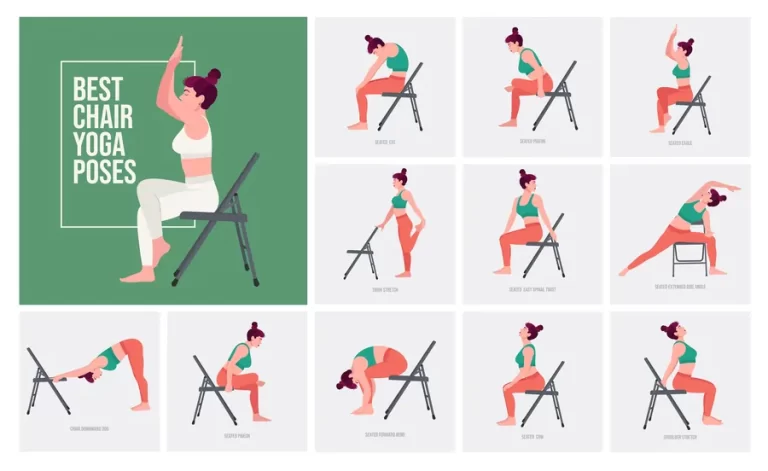
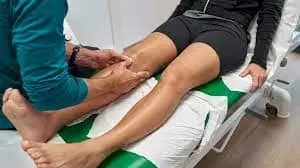
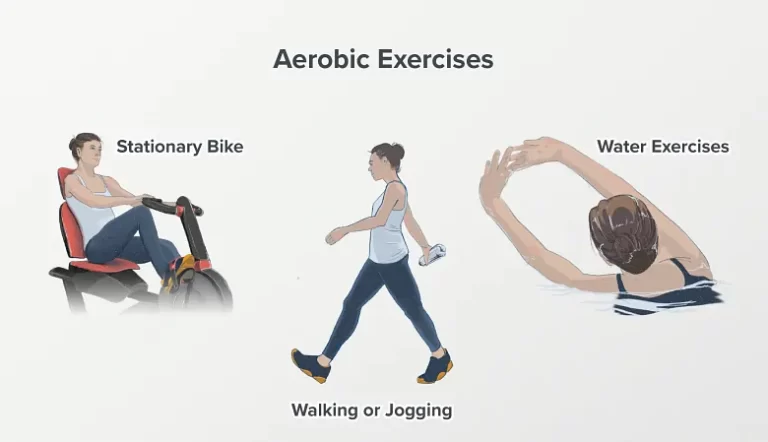

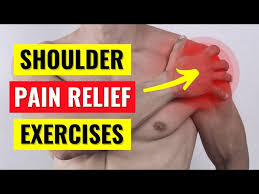

35 Comments